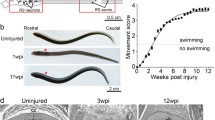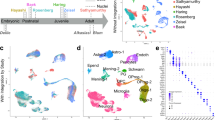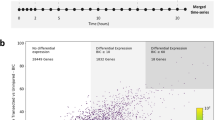Abstract
Comprehensive screens were made for genes that change their expression during a brief critical period in development when neonatal mammalian central nervous system (CNS) loses its capacity to regenerate.
In newly born opossums older than 12 days regeneration ceases to occur in the cervical spinal cord. It continues for 5 more days in lumbar regions. The mRNA’s expressed in cords that do and do not regenerate were analyzed by polymerase chain reaction-based subtractive hybridization. The mRNAs extracted from cervical cords of animals aged 9 and 12 days were subtracted reciprocally, old from young and young from old.
Additional subtractions were made between lumbar regions of 12 day-old cords (which can regenerate) and cervical regions (which cannot). Mini libraries of approximately 2000 opossum cDNA clones resulted from each subtraction. Many sequences were novel. Others that were expressed differentially were related to cell growth, proliferation, differentiation, motility, adhesion, cytoskeleton and extracellular matrix.
A major task was to narrow the search and to eliminate genes that were not associated with regeneration. Clones from different subtractions were cross-hybridized. After those common to regenerating and nonregenerating cords were rejected, approximately 284 sequences of interest remained. Our results revealed novel sequences, as well as genes involved in transcription, cell signaling, myelin formation, growth cone motility, liver regeneration, and nucleic acid and protein management as the candidates important for neuroregeneration.
For selected genes of potential interest for regeneration (for example cadherin, catenin, myelin basic protein), their temporal and spatial distributions and levels of expression in the CNS were measured by Northern blots, semiquantitative and real-time RT-PCR, and in situ hybridization.
Our experiments set the stage for testing the efficacy of candidate genes in turning on or off the capacity for spinal cord regeneration. Opossum spinal cords in vitro provide a reliable and rapid assay for axon outgrowth and synapse formation.
Similar content being viewed by others
References
Blackshaw, S. E., Babington, E. J., Emes, R. D., Malek, J., and Wang, W. Z. (2004). Identifying genes for neuron survival and axon outgrowth in Hirudo medicinalis. J. Anat. 204:13–24.
Bregman, B. S., Coumans, J. V., Dai, H. N., Kuhn, P. L., Lynskey, J., McAtee, M., and Sandhu, F. (2002). Transplants and neurotrophic factors increase regeneration and recovery of function after spinal cord injury. Prog. Brain Res. 137:257–273.
Calegari, F., Marzesco, A. M., Kittler, R., Buchholz, F., and Huttner, W. B. (2004). Tissue-specific RNA interference in post-implantation mouse embryos using directional electroporation and whole embryo culture. Differentiation 72:92–102.
Diatchenko, L., Lau, Y. F., Campbell, A. P., Chenchik, A., Moqadam, F., Huang, B., Lukyanov, S., Lukyanov, K., Gurskaya, N., Sverdlov, E. D., and Siebert, P. D. (1996). Suppression subtractive hybridization: A method for generating differentially regulated or tissue-specific cDNA probes and libraries. Proc. Natl. Acad. Sci. USA 93:6025–30.
Del-Bel, E. A., Joca, S. R., Padovan, C. M., and Guimaraes, F. S. (2002). Effects of isolation-rearing on serotonin-1A and M1-muscarinic receptor messenger RNA expression in the hipocampal formation of rats. Neurosci. Lett. 332:123–126.
DiCicco-Bloom, E., Lelievre, V., Zhou, X., Rodriguez, W., Tam, J., and Waschek, J. A. (2004). Embryonic expression and multifunctional actions of the natriuretic peptides and receptors in the developing nervous system. Dev. Biol. 271:161–75.
Fernández, J., and Nicholls, J. G. (1998). Fine structure and development of dorsal root ganglion neurons and Schwann cells in the newborn opossum, Monodelphis domestica. J. Comp. Neurol. 396:338–350.
Fox, M. A., Colello, R. J., Macklin, W. B., and Fuss, B. (2003). Phosphodiesterase-Ialpha/autotaxin: a counteradhesive protein expressed by oligodendrocytes during onset of myelination. Mol. Cell Neurosci. 23:507–519.
Hatoko, M., Tada, H., Tanaka, A., Kuwahara, M., and Yurugi, S. (2001).The differential expression of N-cadherin in vascularized and nonvascularized nerve grafts: a study in a rat sciatic nerve model. Ann. Plast. Surg. 47:322–327.
Ito, J., Murata, M., and Kawaguchi, S. (2001). Regeneration and recovery of the hearing function of the central auditory pathway by transplants of embryonic tissue in adult rats. Exp. Neurol. 169:30–35.
Jones, T. B., Ankeny, D. P., Guan, Z., McGaughy, V., Fisher, L. C., Basso, D. M., and Popovich, P. G. (2004). Passive or active immunization with myelin basic protein impairs neurological function and exacerbates neuropathology after spinal cord injury in rats. J. Neurosci. 24:3752–3761.
Kawaguchi, S., Iseda, T., and Nishio, T. (2004). Effects of an embryonic repair graft on recovery from spinal cord injury. Prog. Brain Res. 143:155–162.
Kim, J. E., Li, S., GrandPre, T., Qiu, D., and Strittmatter, S. M. (2003). Axon regeneration in young adult mice lacking Nogo-A/B. Neuron 38:187–199.
Lepre, M. J., Fernández, J., and Nicholls, J. G. (1998). Re-establishment of direct synaptic connections between sensory axons and motoneurons after lesions of neonatal opossum CNS (Monodelphis domestica) in culture. Eur. J. Neurosci. 10:2500–2510.
Maes, T., Barcelo, A., and Buesa, C. (2002). Neuron navigator: A human gene family with homology to unc-53, a cell guidance gene from Caenorhabditis elegans. Genomics. 80:21–30.
McBride, C. B., McPhail, L. T., Vanderluit, J. L., Tetzlaff, W., and Steeves, J. D. (2003). Caspase inhibition attenuates transection-induced oligodendrocyte apoptosis in the developing chick spinal cord. Mol. Cell. Neurosci. 23:383–397.
Mikoshiba, K., Aruga, J., and Okano, H. (1991). Molecular biology of myelin basic protein: Gene rearrangement and expression of anti-sense RNA in myelin-deficient mutants. Comp. Biochem. Physiol. C. 98:51–61.
Mladinic, M., Becchetti, A., Didelon, F., Bradbury, A., and Cherubini, E. (1999). Low expression of the CIC-2 chloride channel during postnatal development: A mechanism for the paradoxical depolarizing action of GABA and glycine in the hippocampus. Proc. R. Soc. Lond. B—Biol. Sci. 266:1207–1213.
Nicholls, J. G., Martin, A. R., Wallace, B. G., and Fuchs, P. A. (2001). From Neuron to Brain. 4th ed., Sunderland, MA., Sinauer.
Nicholls, J. G., and Saunders, N. (1996). Regeneration of immature mammalian spinal cord after injury. Trends in Neurosci. 19:229–234.
Nicholls, J. G., Stewart, R. R., Erulkar, S. D., and Saunders, N. R. (1990). Reflexes, fictive respiration and cell division in the brain and spinal cord of the newborn opossum, Monodelphis domestica, isolated and maintained in vitro. J. Exp. Biol. 152:1–15.
Pearse, D. D., Pereira, F. C., Marcillo, A. E., Bates, M. L., Berrocal, Y. A., Filbin, M. T., and Bunge, M. B. (2004). cAMP and Schwann cells promote axonal growth and functional recovery after spinal cord injury. Nat. Med. 10:610–616.
Properzi, F., and Fawcett, J. W. (2004). Proteoglycans and brain repair. News Physiol. Sci. 19:33–38.
Salminen, A., Liu, P. K., and Hsu, C. Y. (1995). Alteration of transcription factor binding activities in the ischemic rat brain. Biochem. Biophys. Res. Commun. 212:939–944.
Sambrook, J., and Russell, D. W. (2001). Molecular Cloning, A Laboratory Manual, 3rd edn., New York, Cold Spring Harbor Laboratory Press.
Saunders, N. R., Balkwill, P., Knott, G., Habgood, M. D., Mø llgard, K., Treherne, J. M., and Nicholls, J. G. (1992). Growth of axons through a lesion in the intact CNS of fetal rat maintained in long-term culture. Proc. R. Soc. Lond. B. 250:171–180.
Saunders, N. R., Kitchener, P., Knott, G. W., Nicholls, J. G., Potter, A., and Smith, T. J. (1998). Development of walking, swimming and neuronal connections after complete spinal cord transection in the neonatal opossum, Monodelphis domestica. J. Neurosci. 180:339–355.
Schwab, M. E. (2004). Nogo and axon regeneration. Curr. Opin. Neurobiol. 14:118–124.
Shibuya, Y., Yasuda, H., Tomatsuri, M., Mizoguchi, A., Takeichi, M., Shimada, K., and Ide, C. (1996). Alpha N-catenin expression in the normal and regenerating chick sciatic nerve. J. Neurocytol. 25:615–624.
Terman, J. R., Wang, X. M., and Martin, G. F. (2000). Repair of the transected spinal cord at different states of development in the North American opossum, Didelphis virginiana. Brain Res. Bull. 53:845–855.
Varga, Z., Bandtlow, C. E., Erulkar, S. D., Schwab, M. E., and Nicholls, J. G. (1995). The critical period for repair of CNS of neonatal opossum (Monodelphis domestica) in culture: correlation with development of glial cells, myelin and growth inhibitory molecules. Eur. J. Neurosci. 7:2119–2129.
von Bernhardi, R., and Muller, K. J. (1995). Repair of the central nervous system: lessons from lesions in leeches. J. Neurobiol. 27:353–366.
Wintzer, M., Mladinic, M., Lazarevic, D., Casseler, C., Cattaneo, A., and Nicholls, J. (2004). Strategies for identifying genes that play a role in spinal cord regeneration. J. Anat. 204:3–11.
Yang, K., Mu, K. S., and Hayes, R. L. (1995). Increased cortical nuclear factor-kappa B (NF-kB) DNA binding activity after traumatic brain injury in rats. Neurosci. Lett. 197:101–104.
Author information
Authors and Affiliations
Corresponding author
Additional information
Contributed as first authors to this work
Rights and permissions
About this article
Cite this article
Mladinic, M., Wintzer, M., Bel, E.D. et al. Differential Expression of Genes at Stages When Regeneration Can and Cannot Occur after Injury to Immature Mammalian Spinal Cord. Cell Mol Neurobiol 25, 407–426 (2005). https://doi.org/10.1007/s10571-005-3150-z
Received:
Accepted:
Issue Date:
DOI: https://doi.org/10.1007/s10571-005-3150-z




